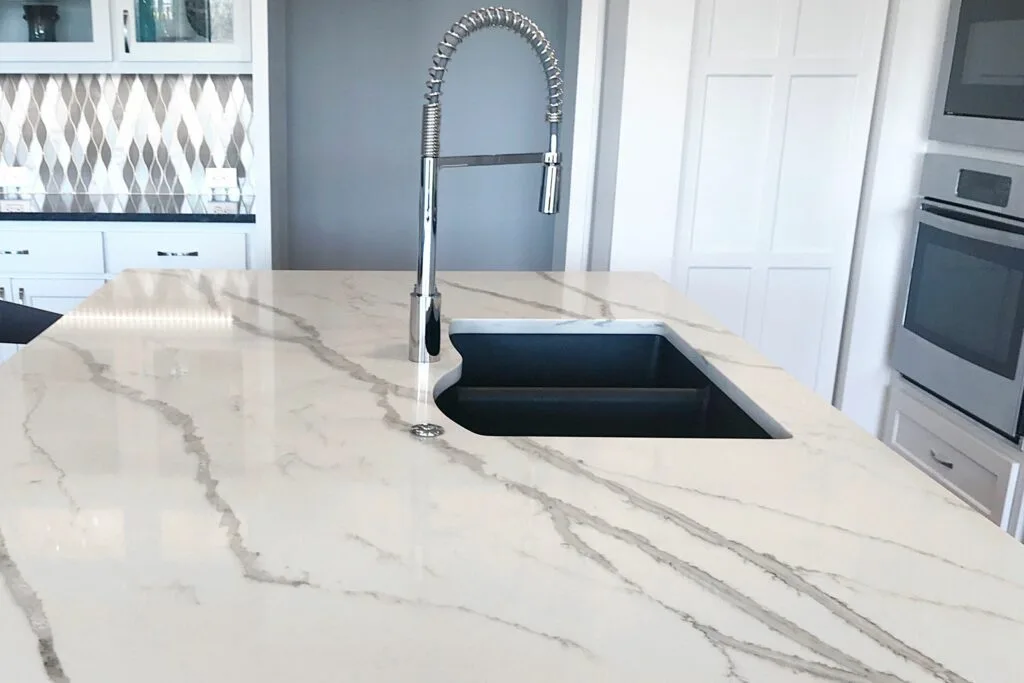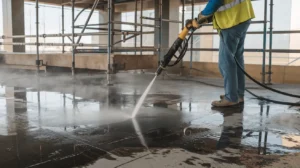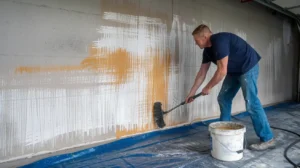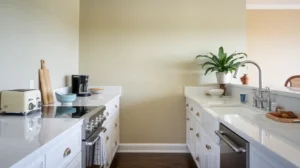Faux marble is a popular alternative to natural marble, offering the look of real stone without the hefty price tag. This material is designed to resemble natural marble, mimicking its color and pattern. Interior designers often recommend faux marble for homeowners who want to achieve the luxurious look of marble countertops at a more affordable cost.

What is Faux Marble Made Of?
Faux marble is typically made from a blend of materials designed to replicate the appearance of real marble. The base is usually a composite material like solid surfacing or cultured marble.
Which is then covered with a gel coating that mimics the veins and patterns found in natural stone. This coating is what gives faux marble its realistic appearance, resembling the intricate details of real marble slabs.
Types of Faux Marble
There are several types of faux marble, each varying in composition and application. Some of the most common include:
Cultured Marble
Cultured marble is a man-made material created by blending crushed marble with resin, resulting in a durable and attractive surface. It’s commonly used for countertops and vanity tops due to its versatility, affordability, and customizable appearance.
The material mimics the look of natural marble but is non-porous, making it easier to maintain and resistant to stains. Cultured marble can be molded into various shapes and sizes, offering a range of design options. Its seamless finish adds a sleek and modern touch to bathrooms and kitchens, making it a popular choice for home renovations.
Faux Stone
Faux stone is a man-made material designed to mimic the appearance of natural marble. Unlike real marble, it is crafted from composite materials, making it more resistant to scratches, stains, and wear. This durability means it’s ideal for high-traffic areas or surfaces that require frequent cleaning.
Additionally, faux stone is easier to maintain, as it doesn’t need sealing or special treatments like natural marble. Its ability to replicate the look of marble while offering enhanced practicality makes it a popular choice for both residential and commercial applications.
Solid Surfacing
Solid surfacing is a versatile, man-made material designed to replicate the appearance of natural stones like marble. It is composed of acrylic or polyester resins combined with pigments and fillers, creating a durable, non-porous surface.
Solid surfacing is popular in kitchens and bathrooms due to its seamless installation, resistance to stains and moisture, and ease of maintenance. Unlike natural stone, it can be easily repaired if scratched or damaged, making it a practical choice for homeowners who want the look of marble without the upkeep challenges.
What are Faux Marble Countertops?
Faux marble countertops are surfaces that mimic the appearance of natural marble but are made from synthetic materials. These countertops are a popular choice in kitchen and bathroom design because they provide the aesthetic appeal of marble without the high cost or maintenance.
Faux marble countertops are often more durable and easier to care for than real marble, making them an attractive option for busy households.
Pros of Faux Marble Countertops
Faux marble countertops offer an affordable alternative to real marble, making them an excellent choice for budget-conscious homeowners. They are more durable, resisting scratches, stains, and heat better than natural marble. Their non-porous nature makes cleaning and maintenance a breeze, as spills and stains can be wiped away with ease.
Available in a wide range of colors and patterns, faux marble allows for greater design flexibility, catering to various styles and preferences. Additionally, these countertops are lighter than natural stone, simplifying installation and reducing the need for extra structural support.
Cons of Faux Marble Countertops
Faux marble countertops, while an affordable alternative to genuine marble, have several drawbacks. They lack the natural beauty and unique variations that give real marble its distinct appeal, making them appear less authentic.
Although they are more durable than natural marble, faux marble surfaces can still be damaged by sharp objects or excessive heat, requiring careful maintenance.
Additionally, faux marble may not contribute as much to your home’s resale value since it is considered an artificial material. Its lifespan is also shorter compared to natural marble, especially in high-traffic areas like kitchens, where wear and tear are more prominent.
Can I Install Faux Marble Countertops Myself?
Yes, you can install faux marble countertops yourself with the right tools and preparation. However, it’s important to follow each step carefully to ensure a professional-looking result. Here’s a step-by-step guide to help you through the process.
Step 1: Measure the Area
The first step in installing faux marble countertops is to measure the area where you’ll be installing the countertop. Accurate measurements are crucial to ensure that the countertop fits perfectly. Measure the length and width of the space, taking note of any cutouts needed for sinks or appliances.
Step 2: Prepare the Surface
Before installing the countertop, make sure the surface is clean, level, and free of any debris. If you’re replacing an old countertop, remove it carefully and inspect the base for any damage. Repair any issues before proceeding to ensure a smooth installation.
Step 3: Cut and Install the Faux Marble Countertop
Using the measurements you took earlier, cut the faux marble to the appropriate size. You can use a circular saw with a fine-tooth blade for this step. Once the countertop is cut to size, carefully place it on the prepared surface, making sure it fits snugly. Use adhesive to secure the countertop in place, following the manufacturer’s instructions.
Step 4: Seal the Edges
After the countertop is installed, it’s important to seal the edges to prevent moisture from seeping underneath. Apply a bead of silicone caulk around the edges, smoothing it out with a caulk tool or your finger. This will create a watertight seal that helps protect the countertop and the underlying surface.
Step 5: Finishing Touches
Finally, add any finishing touches to complete the installation. This may include installing backsplashes, caulking seams, or polishing the surface for a glossy finish. Once everything is in place, your faux marble countertop is ready to use.
Get the Help of Experts at Stone Sealer
While installing faux marble countertops yourself can be a rewarding project, it’s not without its challenges. If you’re unsure about the process or want to ensure a flawless installation, consider getting the help of experts.
At Stone Sealer, we specialize in the installation and maintenance of faux marble countertops. Our team of professionals has the experience and expertise to handle every aspect of the installation, ensuring your countertops look stunning and last for years to come.
Whether you’re looking to enhance your kitchen with the look of marble or need guidance on choosing the right material, Stone Sealer is here to help.
Conclusion
Faux marble offers a cost-effective and stylish alternative to natural marble, providing the same luxurious appearance without the high maintenance and expense. With various types of faux marble countertops available, homeowners can find a solution that fits their needs and budget.
Whether you’re tackling a DIY installation or seeking professional assistance, understanding the pros and cons of faux marble countertops will help you make an informed decision. If you’re ready to transform your space with the timeless beauty of marble, consider faux marble as a practical and beautiful option.
And for a seamless installation experience, don’t hesitate to reach out to the experts at Stone Sealer. Contact us today to learn more about our services and how we can assist you in achieving the perfect look for your home.






